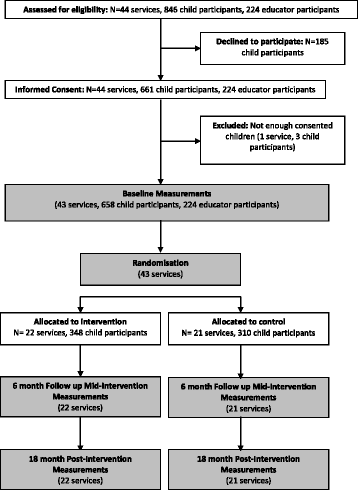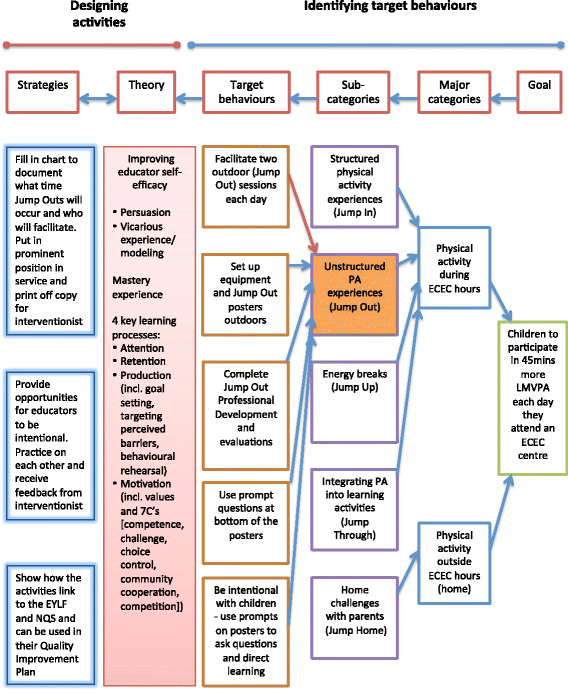Increasing physical activity among young children from disadvantaged communities: study protocol of a group randomised controlled effectiveness trial
- PMID: 27756277
- PMCID: PMC5069890
- DOI: 10.1186/s12889-016-3743-0
Increasing physical activity among young children from disadvantaged communities: study protocol of a group randomised controlled effectiveness trial
Abstract
Background: Participation in regular physical activity (PA) during the early years helps children achieve healthy body weight and can substantially improve motor development, bone health, psychosocial health and cognitive development. Despite common assumptions that young children are naturally active, evidence shows that they are insufficiently active for health and developmental benefits. Exploring strategies to increase physical activity in young children is a public health and research priority.
Methods: Jump Start is a multi-component, multi-setting PA and gross motor skill intervention for young children aged 3-5 years in disadvantaged areas of New South Wales, Australia. The intervention will be evaluated using a two-arm, parallel group, randomised cluster trial. The Jump Start protocol was based on Social Cognitive Theory and includes five components: a structured gross motor skill lesson (Jump In); unstructured outdoor PA and gross motor skill time (Jump Out); energy breaks (Jump Up); activities connecting movement to learning experiences (Jump Through); and a home-based family component to promote PA and gross motor skill (Jump Home). Early childhood education and care centres will be demographically matched and randomised to Jump Start (intervention) or usual practice (comparison) group. The intervention group receive Jump Start professional development, program resources, monthly newsletters and ongoing intervention support. Outcomes include change in total PA (accelerometers) within centre hours, gross motor skill development (Test of Gross Motor Development-2), weight status (body mass index), bone strength (Sunlight MiniOmni Ultrasound Bone Sonometer), self-regulation (Heads-Toes-Knees-Shoulders, executive function tasks, and proxy-report Temperament and Approaches to learning scales), and educator and parent self-efficacy. Extensive quantitative and qualitative process evaluation and a cost-effectiveness evaluation will be conducted.
Discussion: The Jump Start intervention is a unique program to address low levels of PA and gross motor skill proficiency, and support healthy lifestyle behaviours among young children in disadvantaged communities. If shown to be efficacious, the Jump Start approach can be expected to have implications for early childhood education and care policies and practices, and ultimately a positive effect on the health and development across the life course.
Trial registration: Australian and New Zealand Clinical Trials Registry No: ACTRN12614000597695 , first received: June 5, 2014.
Keywords: Cluster randomised controlled trial; Early years; Motor skill; Physical activity; Preschool; Professional development.
Figures
Similar articles
-
Evaluation of the Preschool Situational Self-Regulation Toolkit (PRSIST) Program for Supporting children's early self-regulation development: study protocol for a cluster randomized controlled trial.Trials. 2018 Jan 24;19(1):64. doi: 10.1186/s13063-018-2455-4. Trials. 2018. PMID: 29368622 Free PMC article.
-
Study protocol for Active Start Active Future: a randomised control trial of an early behaviour-change intervention targeting physical activity participation and sedentary behaviour in young children with cerebral palsy living in South East Queensland, Australia.BMJ Open. 2025 May 19;15(5):e087697. doi: 10.1136/bmjopen-2024-087697. BMJ Open. 2025. PMID: 40389315 Free PMC article.
-
'Jump start' childcare-based intervention to promote physical activity in pre-schoolers: six-month findings from a cluster randomised trial.Int J Behav Nutr Phys Act. 2020 Jan 16;17(1):6. doi: 10.1186/s12966-020-0910-6. Int J Behav Nutr Phys Act. 2020. PMID: 31948454 Free PMC article. Clinical Trial.
-
Effects of movement behaviors on preschoolers' cognition: a systematic review of randomized controlled trials.Int J Behav Nutr Phys Act. 2025 Jan 23;22(1):12. doi: 10.1186/s12966-025-01705-y. Int J Behav Nutr Phys Act. 2025. PMID: 39849503 Free PMC article.
-
Effects of Physical Activity on Children's Motor Skill Development: A Systematic Review of Randomized Controlled Trials.Biomed Res Int. 2020 Dec 30;2020:8160756. doi: 10.1155/2020/8160756. eCollection 2020. Biomed Res Int. 2020. PMID: 33457415 Free PMC article.
Cited by
-
Physiological Characteristics of Young (9-12 Years) and Adolescent (≥13 Years) Rhythmic, Acrobatic, and Artistic Female Gymnasts.Sports Health. 2025 Feb 4:19417381251314077. doi: 10.1177/19417381251314077. Online ahead of print. Sports Health. 2025. PMID: 39905597 Free PMC article.
-
Determining Factors in the Use of Urban Parks That Influence the Practice of Physical Activity in Children: A Systematic Review.Int J Environ Res Public Health. 2021 Mar 31;18(7):3648. doi: 10.3390/ijerph18073648. Int J Environ Res Public Health. 2021. PMID: 33807466 Free PMC article.
-
A blended professional learning intervention for early childhood educators to target the promotion of physical activity and healthy eating: the HOPPEL cluster randomized stepped-wedge trial.BMC Public Health. 2022 Jul 15;22(1):1353. doi: 10.1186/s12889-022-13542-w. BMC Public Health. 2022. PMID: 35841084 Free PMC article. Clinical Trial.
-
Physical activity, diet and other behavioural interventions for improving cognition and school achievement in children and adolescents with obesity or overweight.Cochrane Database Syst Rev. 2018 Jan 29;1(1):CD009728. doi: 10.1002/14651858.CD009728.pub3. Cochrane Database Syst Rev. 2018. Update in: Cochrane Database Syst Rev. 2018 Mar 02;3:CD009728. doi: 10.1002/14651858.CD009728.pub4. PMID: 29376563 Free PMC article. Updated.
-
Potential Efficacy of the MOVERS Professional Development Programme: A Pilot Randomised Controlled Trial.Child Care Health Dev. 2025 Sep;51(5):e70146. doi: 10.1111/cch.70146. Child Care Health Dev. 2025. PMID: 40741636 Free PMC article. Clinical Trial.
References
-
- National Association for Sport and Physical Education. Active start: a statement of physical activity guidelines for children birth to five years. In. Edited by American Alliance for Health PE, Recreation and Dance. Reston: 2002.
-
- UK Department of Health . Start active, stay active: a report on physical activity from the four home countries’ chief medical officers. London: UK Department of Health; 2011.
Publication types
MeSH terms
Associated data
LinkOut - more resources
Full Text Sources
Other Literature Sources
Medical



